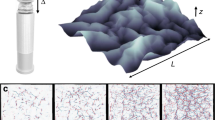Abstract
The dynamics of a “peeling front” or an elastic line is studied under creep (constant load) conditions. Our experiments show in most cases an exponential dependence of the creep velocity on the inverse force (mass) applied. In particular, the dynamical correlations of the avalanche activity are discussed here. We compare various avalanche statistics to those of a line with non-local elasticity, and study various measures of the experimental avalanche-avalanche and temporal correlations such as the autocorrelation function of the released energy and aftershock activity. From all these we conclude, that internal avalanche dynamics seems to follow “line depinning”-like behavior, in rough agreement with the depinning model. Meanwhile, the correlations reveal subtle complications not implied by depinning theory. Moreover, we also show how these results can be understood from a geophysical point of view.
Similar content being viewed by others
References
Alava MJ, Niskanen K (2006) The physics of paper. Rep Prog Phys 69: 669–723
Alava MJ, Nukala PKVV, Zapperi S (2006) Statistical models of fracture. Adv Phys 55: 349–476
Bonamy D, Ponson L, Prades S, Bouchaud E, Guillot C (2006) Scaling exponents for fracture surfaces in homogeneous glass and glassy ceramics. Phys Rev Lett 97: 135504
Braun Th, Kleemann W, Dec J, Thomas PA (2005) Creep and relaxation dynamics of domain walls in periodically poled KTiOPO4. Phys Rev Lett 94: 117601
Chauve P, Giamarchi T, Le Doussal P (2000) Creep and depinning in disordered media. Phys Rev E 62: 6241–6267
Corral A (2004) Long-term clustering, scaling, and universality in the temporal occurrence of earthquakes. Phys Rev Lett 92: 10851
Davidsen J, Stanchits S, Dresen G (2007) Scaling and universality in rock fracture. Phys Rev Lett 98: 125502
Duemmer O, Krauth W (2007) Depinning exponents of the driven long-range elastic string. J Stat Mech P01019. http://www.iop.org/EJ/abstract/1742-5468/2007/01/P01019
Fisher DS (1998) Collective transport in random media: from superconductors to earthquakes. Phys Rep 301: 113–150
Hainzl S, Ogata Y (2005) Detecting fluid signals in seismicity data through statistical earthquake modeling. J Geophys Res 110: B05S07
Helmstetter A, Sornette D (2002) Diffusion of epicenters of earthquake aftershocks, Omori?s law, and generalized continuous-time random walk models. Phys Rev E 66: 061104
Helmstetter A, Sornette D, Grasso JR (2003) Mainshocks are aftershocks of conditional foreshocks: how do foreshock statistical properties emerge from aftershock laws. J Geophys Res 108(B1): 2046
Ioffe LB, Vinokur VM (1987) Dynamics of interfaces and dislocations in disordered media. J Phys C 20: 6149–6158
Kagan YY, Knopoff L (1981) Stochastic synthesis of earthquake catalogs. J Geophys Res 86(B4): 2853–2862
Kertész J, Horvath VK, Weber F (1993) Self-affine rupture lines in paper sheets. Fractals 1: 67–74
Koivisto J, Rosti J, Alava MJ (2007) Creep of a fracture line in paper peeling. Phys Rev Lett 99: 145504
Kolton AB., Rosso A., Giamarchi T. (2005) Creep motion of an elastic string in a random potential Phys Rev Lett 94: 047002
Lemerle S, Ferré J, Chappert C, Mathet V, Giamarchi T, Le Doussal P (1998) Wall creep in an ising ultrathin magnetic film. Phys Rev Lett 80: 849–852
Måløy KJ, Santucci S, Schmittbuhl J, Toussaint R (2006) Local waiting time fluctuations along a randomly pinned crack front. Phys Rev Lett 96: 045501
Molchan G (2005) Interevent time distribution in seismicity: a theoretical approach. Pure Appl Geophys 162: 1135–1150
Nattermann T (1987) Interface roughening in systems with quenched random impurities. Europhys Lett 4: 1241–1246
Nattermann T, Shapir Y, Vilfan I (1990) Interface pinning and dynamics in random systems. Phys Rev B 42: 8577–8586
Ramanathan S, Fisher DS (1997) Dynamics and instabilities of planar tensile cracks in heterogeneous media. Phys Rev Lett 79: 877–880
Rosso A, Krauth W (2001) Origin of the roughness exponent in elastic strings at the depinning threshold. Phys Rev Lett 87: 187002
Rosso A, Krauth W (2002) Roughness at the depinning threshold for a long-range elastic string. Phys Rev E 65: 025101
Saichev A, Sornette D (2007) Theory of earthquake recurrence times. J Geophys Res 112: B04313
Salminen LI, Tolvanen AI, Alava MJ (2002) Acoustic emission from paper fracture. Phys Rev Lett 89: 185503
Salminen LI, Pulakka JM, Rosti J, Alava MJ, Niskanen KJ (2006) Crackling noise in paper peeling. Europhys Lett 73: 55–61
Santucci S, Vanel L, Ciliberto S (2004) Subcritical statistics in rupture of fibrous materials: experiments and model. Phys Rev Lett 93: 095505
Schmittbuhl J, Måløy KJ (1997) Direct observation of a self-affine crack propagation. Phys Rev Lett 78: 3888–3891
Schmittbuhl J, Roux S, Vilotte JP, Måløy KJ (1995) Interfacial crack pinning: effect of nonlocal interactions. Phys Rev Lett 74: 1787–1790
Sethna JP, Dahmen KA, Myers CR (2001) Crackling noise. Nature 410: 242–250
Tanguy A, Gounelle M, Roux A (1998) From individual to collective pinning: Effect of long-range elastic interactions. Phys Rev E 58: 1577–1590
Tybell T, Paruch P, Giamarchi T, Triscone J-M (2002) Domain wall creep in epitaxial ferroelectric Pb(Zr0.2Ti0.8)O3 thin films. Phys Rev Lett 89: 097601
Utsu T, Ogata Y, Matsuura S (1995) The centenary of the Omori formula for a decay law of aftershock activity. J Phys Earth 43: 1–33
Weiss J, Marsan D (2003) Three-dimensional mapping of dislocation avalanches: clustering and space/time coupling. Science 299: 89–92
Yu Y, Kärenlampi P (1997) On crack stability in paper toughness testing. J Mat Sci 32: 6513–6517
Author information
Authors and Affiliations
Corresponding author
Additional information
This article has been previously published in Fracture 151, issue 2, pp. 281–297. doi:10.1007/s10704-008-9258-7.
Rights and permissions
About this article
Cite this article
Rosti, J., Koivisto, J., Traversa, P. et al. Line creep in paper peeling. Int J Fract 154, 147–158 (2008). https://doi.org/10.1007/s10704-009-9312-0
Received:
Published:
Issue Date:
DOI: https://doi.org/10.1007/s10704-009-9312-0




